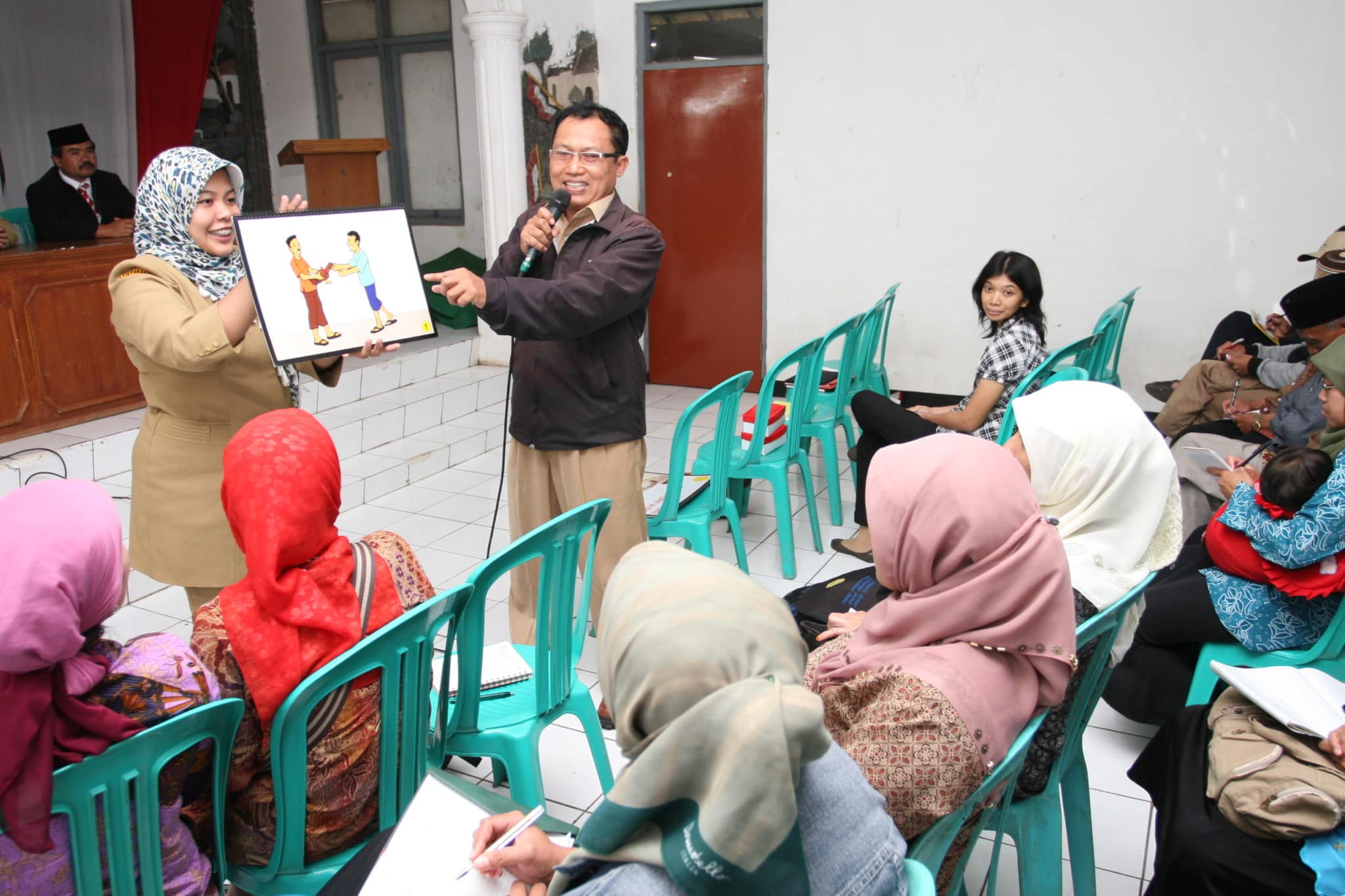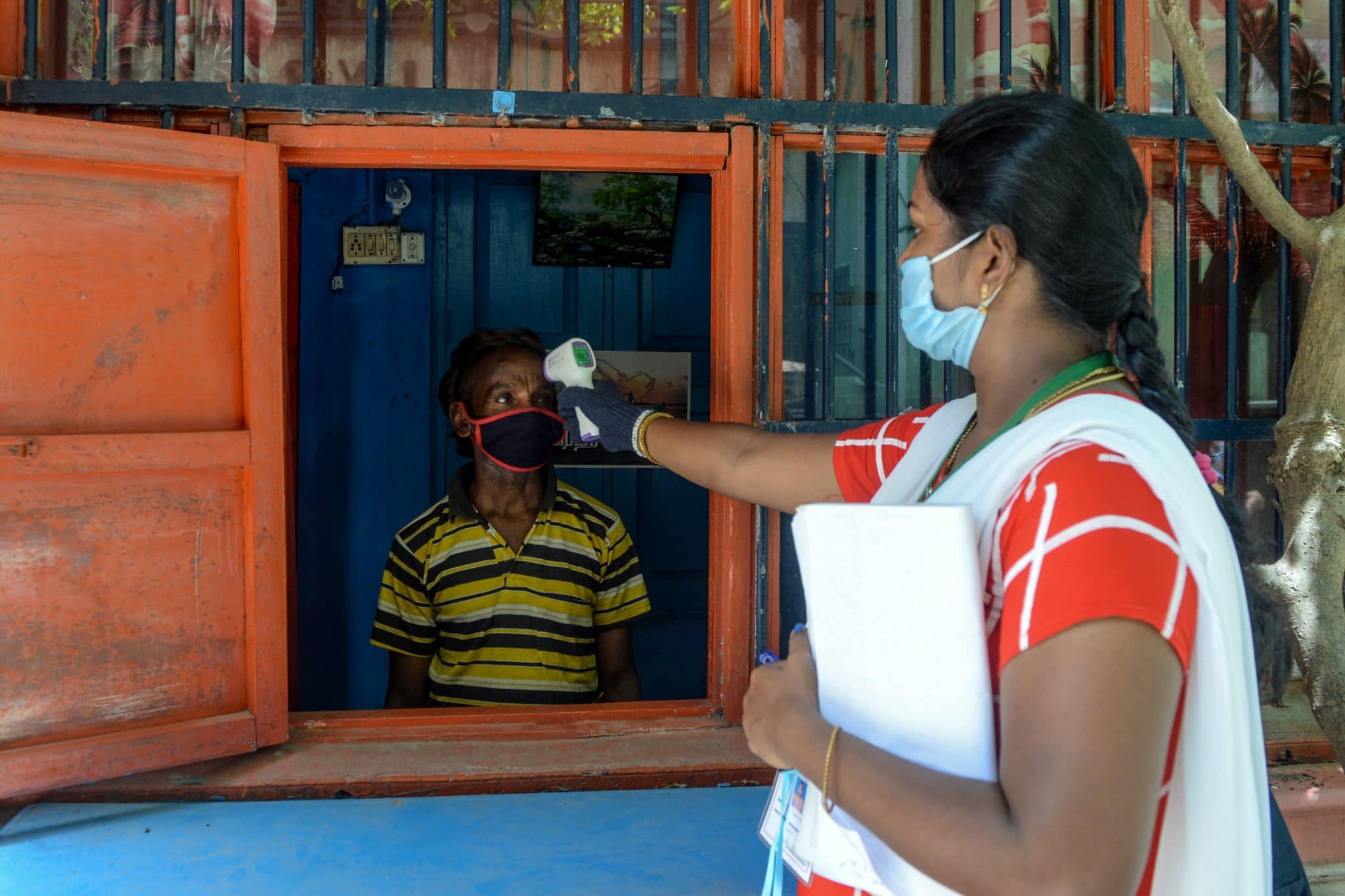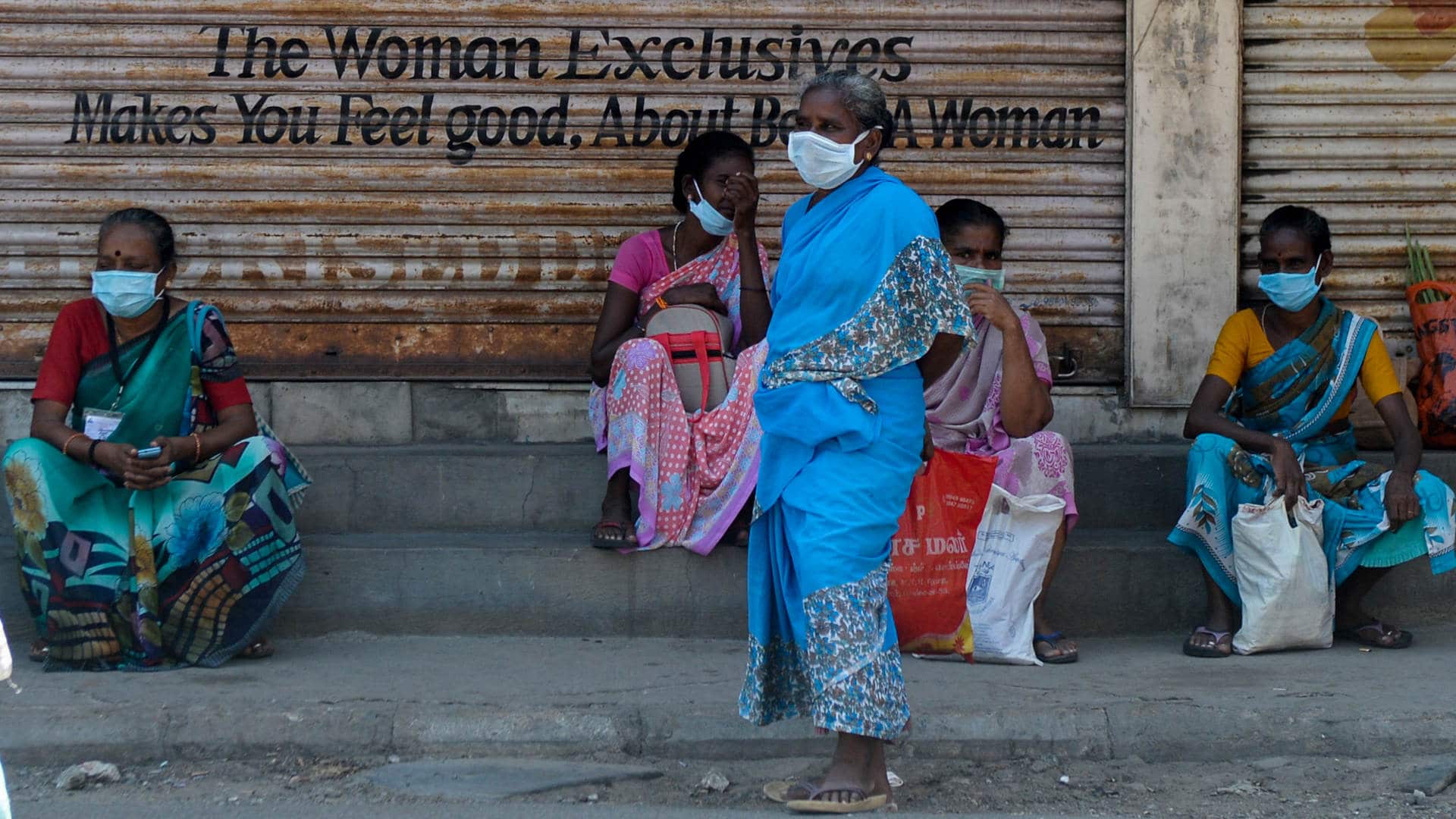When a Contagion Comes, Women Bear a Heavy Burden
Suganya Prakash, 21, left at 8 a.m. from her home in a crowded area of Chennai, a city of 7 million in South India. After a quick breakfast and a visit to the offices of the Chennai Corporation, the civic body governing the city, she donned a surgical mask and, carrying a notebook and a ballpoint pen, walked to the first of 250 houses on her list. It was already 90 degrees and her mask hung askew as she climbed a flight of stairs to the second floor of a turquoise-painted duplex in Mylapore, a well-to-do neighborhood. The front door was open.
“I’m from the Corporation and I’ve come for a survey,” Suganya said in Tamil to the old man seated near the door. She opened her notebook. Five people — three generations — crowded around her. She didn’t fix her mask. “How many members? How old is everyone? Does anyone have any disease? Any fever?”
Suganya was part of a 16,000-strong surveillance team in Chennai that, in April, was going door-to-door with minimal personal protective equipment to find people infected with Covid-19. Most of these census takers are women, often poor, who are attracted to the risky job by its salary of 15,000 rupees ($200) a month — a good wage at a time when more than 100 million in India are without work. And it’s not just in India. In Bangladesh’s Cox’s Bazar, home to the world’s largest refugee camp, Rohingya women are going door-to-door to educate people on the importance of washing hands and maintaining social distancing. In China’s Hubei Province, where the novel coronavirus originated, women make up 90 percent of the health care workforce.
“With the Covid crisis, we’re seeing that women are bearing the social and economic impacts to a disproportionate degree,” said Julia Smith, a research associate at Simon Fraser University in British Columbia, who is part of a global team examining the gendered effects of Covid-19. “They are also on the front lines responding to the outbreak.”
To be sure, the virus itself takes a greater toll on men, who are statistically more likely to die from Covid-19 once infected — two times more likely, according to some studies. Precisely why remains unclear.
Still, that grim statistic belies a complicated situation on the ground, where the impacts of the pandemic ripple through women’s lives in profound ways. From nurses and doctors to contract tracers and community volunteers, women are disproportionately represented on the front lines of health care delivery and management for the millions of cases of Covid-19 around the world. Meanwhile, women-dominated industries like service and personal care have suffered some of the greatest job losses during the economic contraction. In turn, across the world — in rich countries as well as developing ones — women have been more likely to shoulder the burden of caring for children and elderly family members during widespread lockdowns, as well as suffering higher rates of domestic violence and higher levels of anxiety and stress.
Gendered patterns have surfaced amid other contagions, from HIV to Ebola, but experts say the disparate impacts on women in the midst of a fast-spreading disease are only now being studied in earnest — and none too soon. They warn that the long-term impacts of Covid-19 on the lives of women could roll back gains made over decades, in part because in the mad rush to address the looming public health crisis, most nations have failed to consider gender when planning their responses. “We need to understand those things,” Smith said, “if we’re going to make sure that those most in need get the help they need.”
The HIV/AIDs epidemic first revealed to researchers in the 1990s the importance of the fact that men, women, and non-binary people experience infectious diseases differently, and that cultural expectations about appropriate male and female behavior matter. “At different levels, gender affects your risk exposure,” said Sara Davies, professor at the School of Government and International Relations at Griffith University in Australia. “It affects how your body will react, and it also affects the consequences of getting infected.”
Davies was in Thailand in the late 2000s, at the tail end of the H5N1 — avian influenza — outbreak across Southeast Asia. Between 2003 and 2009, there were 468 confirmed infections resulting in 282 deaths worldwide. Davies noticed that most workers monitoring H5N1 on the ground were women, while men dominated all the policy workshops that Davies attended. Even the messaging seemed biased to Davies. Men were told about impacts on the job, while women — who also often worked — received instructions about household care, such as how to check for fever or sanitize surfaces.

The dominance of men at the top echelons of health policy has meant that the male body is considered the default in these discussions, said Anna Purdie, program manager for Global Health 50/50, an initiative focused on gender equality in global health based at University College London. For example, most clinical trials have a male bias. Heart attacks in women, which can cause atypical symptoms such as jaw pain, often go unrecognized because the default understanding is the male experience. On the flip side, men tend to seek medical care later than women due to cultural norms.
When Ebola broke out in in Liberia, Sierra Leone, and Guinea in 2014, these nations in West Africa were already struggling with lack of access to school for girls, teenage pregnancy, domestic violence, and adequate maternal health care. In the Kailahun and Kenema Districts of eastern Sierra Leone, for example, there was only one hospital for about 670,000 people, so the sick were often cared for at home by women.
But as authorities scrambled to respond, gender was still mostly ignored, said Sophie Harman, a professor of international politics at Queen Mary University of London. She found that out of some 61 publications on the outbreak in the year ending February 2015, only two spoke of women and acknowledged their risk as primary caregivers.
The World Health Organization (WHO) did not publish gender-disaggregated data until a year after the outbreak began, and the data, when it was published, suggested that Ebola equally impacted men and women.
But global health experts on the ground could see that the statistical gender parity in the sparse data hid a world of nuance. Some research has found that women who survived Ebola disproportionately suffered secondary and long-term social impacts, such as being more likely to experience community stigma and ostracization. In Sierra Leone, as the health care system become overwhelmed with cases, 30 percent fewer women accessed routine health care, and pregnant women came to clinics only after facing obstetric complications because they worried about catching the disease. In Liberia, more women gave birth without the attendance of a health care professional of any kind. And among the women who did make it to the hospital, maternal mortality and stillbirth increased.
Women were also more likely to lose their jobs and remain out of work as economies contracted during the crisis. A 2015 World Bank report found that 60 percent of women in Liberia remained unemployed a year after the outbreak began, compared to 40 percent of men. In one micro-finance group set up to empower women in Kailahun in Sierra Leone that Smith of Simon Fraser University worked with, nine out of 35 women died of Ebola.
“The wide, rippling effects were just almost too much to comprehend,” Smith said.
Experts published papers on gender and infectious disease in academic journals, but Harman suggested these findings were largely ignored until women in Europe and the United States began experiencing negative impacts during the Covid-19 pandemic. “Gender has historically flown under the radar when it comes to infectious disease,” she said. “That’s because it has mostly affected women in the global south. But Covid is different; it has affected women in the north.”
During her rounds in April, Malathi Sasikumar was frazzled; as part of the team knocking on doors in Chennai, she was responsible for managing 75 surveillance workers in the area in addition to making her own visits. She stopped outside a cramped three-story apartment building where a woman had reported Covid-19 symptoms and rang the doorbell. The vendor at the milk depot next door, which was permitted to operate during the lockdown, said in Tamil, “I don’t know how you do this. I’d be scared. You are very brave.”
A woman appeared on a second-floor balcony and gestured to Malathi to come upstairs. She climbed up and paused on the tiny landing. The woman gestured for her to enter. Malathi, who was wearing a surgical mask and white cloth gloves, hesitated. “No, we just want to ask you about your fever,” she said. But the woman insisted, and Malathi removed her sandals and went in. The room smelled musty; there were no windows. A surgical mask hung on a nail; the woman’s face was uncovered. A muted television played the day’s news.
The woman asked Malathi to sit next to her on the sofa. Malathi hesitated again before sitting down to hear the woman better. The woman said she worked for the government and was constantly around people. She was worried that she had the virus and wanted to get tested. Malathi assured her a doctor would check on her that evening.
Back on the street, Malathi explained her thinking. “I was very scared,” she said of entering the woman’s home. “But the woman wouldn’t listen, and I had to go in.”

Data on Covid-19 shows that men are more likely to die once infected. In some parts of the world, such as South Asia and the Middle East, men are also more likely to be confirmed as infected. “We don’t know whether that’s because more men have access to testing, or because more men are getting more infected than women because they are outside more,” said Purdie of Global Health 50/50.
But within the health care sector, women are faring worse. This is unsurprising as women make up 70 percent of the world’s health care workers. In Spain, Italy, and the United States, between two thirds and three quarters of infections in health care workers are in women.
In almost all nations, nurses have complained about unsafe conditions. In India, where 90 percent of nurses are women, some hospitals require staff to work up to 12-hour shifts while wearing stifling personal protective equipment (PPE), said Joldin Francis, general secretary of the United Nurses Association’s New Delhi chapter. The women cannot take toilet breaks while wearing PPE, and they complete weeklong assignments in Covid-19 wards, only to return home and worry about transmitting the virus to their families. They are under great mental strain, he said.
It’s been difficult to fully understand the impact of Covid-19 on men and women because gender-disaggregated data are not easily available. Only 60 out of 194 member nations of the WHO are supplying such data consistently, Davies of Griffith University said.
“It’s been really shocking,” she said. “I’m on a project and we’re trying to collect it, and it’s really hard. We have a suspicion that sometimes it probably is being collected, but it’s just not being shared.”
Experts say policymakers must go beyond infection and mortality statistics while crafting policies. There have been knock-on effects on women, but getting relevant data on issues such as domestic violence has been challenging, said Tara Cookson, a postdoctoral research fellow at the University of British Columbia in Vancouver and co-founder of Ladysmith, a feminist research consultancy.
“It’s really hard to collect data on this at the moment because you’re not sending around someone to do a household survey,” she said.
Kamalam John’s occupation is snipping away excess threads from hemmed garments, putting in drawstrings, and other piece work for the garment industry. She had taken up this job a decade ago as it allowed her to earn from home while taking care of her family. And when Covid-19 hit, she was on the lowest rung of a garment supply chain in Tiruppur, a city 250 miles southeast of Chennai, which supplies domestic companies as well as major international fashion brands such as Zara.
Kamalam, 45, usually earns at least a quarter of a rupee (a fraction of a cent) per garment she processes, but as of early July, she hadn’t worked for three months. Her husband, a full-time tailor at the local firm AKR Textiles, had also lost his job. They hadn’t paid the rent on their house for the previous three months. Like many women here, Kamalam had taken out a microfinance loan and the representative was clamoring for dues. She estimated that half of the home-based workers in Tiruppur like her were still unemployed, and even the work that still trickled in paid lower rates.
“We don’t have work,” she said in Tamil. “Instead of being able to plan out our lives, suddenly, there’s this problem in nature. We cannot handle the shock.”
Janhavi Dave, international coordinator of HomeNet South Asia, an NGO that represents 900,000 home-based workers, the majority women, said that most have not earned a wage since March. “They’re almost desperate for work, for an income,” she said.
Economists say that women have been more likely than men to lose their jobs during the pandemic, as the sectors dominated by women, such as retail and hospitality, have been hit hard. Globally, an estimated 220 million women are employed in at-risk sectors.
Women are also handing much of the burden of caring for children, as well as ill and elderly relatives, in both the developed and developing world. “The only place [many women] used to work, which is their own home, is gone because now a lot of people are there,” Dave said.
As nations locked down, some women were stuck with violent partners. Helplines around the world noted an uptick in distress calls. In France, domestic violence reports increased by 30 percent. In Cyprus and Singapore, calls increased by even more. In India, some helplines shut down at the beginning of the lockdown, leaving women with nowhere to turn, according to Dave.
“They reached out to police, but the police were too busy, you know, implementing the lockdown and asked them to manage it on their own,” she said.
While there has been a growing outcry over the disparate impacts of the pandemic on women, nations haven’t really applied a gender lens to their policymaking, according to Harman. If they had, they would have known that domestic violence would increase during a lockdown and devoted resources to addressing the spike.
Women have also been mostly absent at the topmost levels of outbreak response. In the United States, the White House Coronavirus Task Force, for example, has only two women among its 27 members. This mirrors the absence of women in the decision-making roles across the health care sector worldwide, where less than one-third of organizations have equal numbers of men and women, according to an analysis by Global Health 50/50.
While the WHO does have a gender unit, Davies noted, their research does not always surface in the work of the health emergencies program. “There’s not a lot of consistent international level policy,” Davies said, “on the gendered impacts of pandemics.”
Gayathri Vaidyanathan is an independent, India-based journalist writing about the environment, science, and society.











